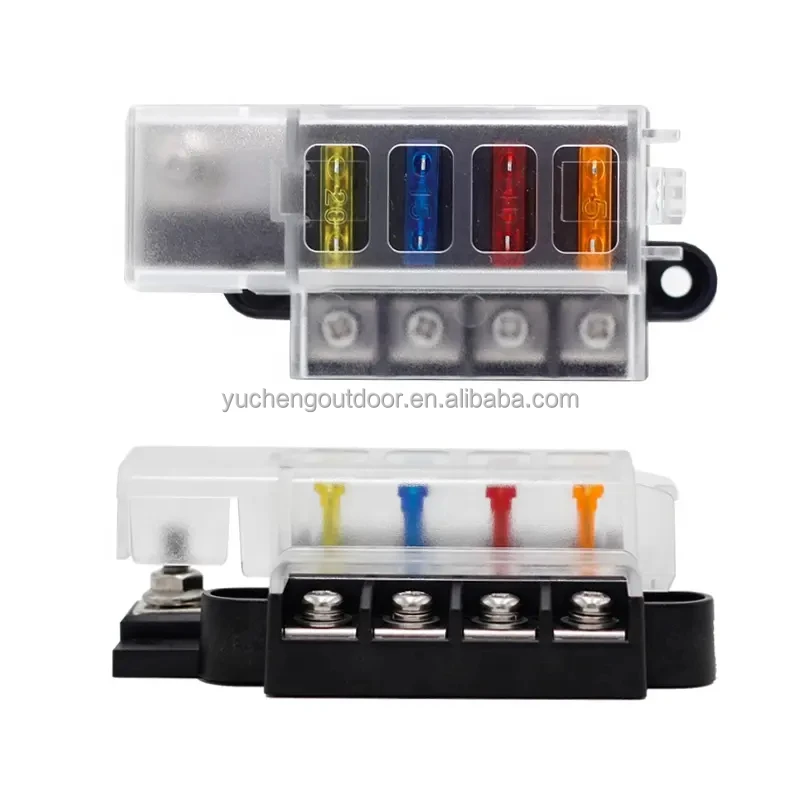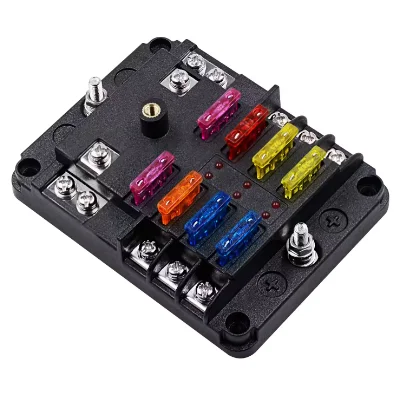Apr 17,2025
0
Thermal and magnetic trip mechanisms in fuse blocks play a crucial role in preventing electrical overloads. Thermal trip mechanisms are designed to react to heat generated from overload conditions by utilizing a bimetallic strip, which bends when heated due to excessive current. This bending action triggers the breaker, effectively stopping the flow of electricity and preventing overheating, thereby safeguarding against potential electrical fires. On the other hand, magnetic trip mechanisms operate swiftly in response to short circuits. These mechanisms use a solenoid that reacts to sudden spikes in current, minimizing the risk of electrical fires or damage by quickly breaking the circuit.
Industry standards highlight these mechanisms' effectiveness in preventing electrical hazards. According to experts, the combination of thermal and magnetic elements in modern fuse blocks significantly enhances their ability to detect and address electrical threats promptly. This dual mechanism is highly valued for its reliability, ensuring that electrical circuits are protected from both gradual and sudden overloads, thereby contributing to overall safety in electrical systems.
Fuse blocks are designed to interrupt fault currents swiftly, preventing damage to electrical systems. When a fault current is detected, the fuse quickly breaks the circuit, stopping the flow of electricity with a high degree of reliability. This fast action is crucial in avoiding potential damages such as equipment failure and safety hazards. If fault currents are not interrupted promptly, they can cause extensive damage, leading to costly repairs and posing risks to personnel and infrastructure.
The importance of fuse blocks in interrupting fault currents is underscored by various incidents where effective interruption minimized damages. For instance, case studies show instances where timely action by fuse blocks prevented catastrophic failures and enhanced safety protocols. This highlights the necessity of fuse blocks as integral components of electrical safety systems, ensuring equipment protection and mitigating risks associated with uncontrolled fault currents. By consistently interrupting these currents before damage and danger arise, fuse blocks significantly contribute to maintaining safe and efficient electrical operations.
Selecting the appropriate current rating for fuse blocks is crucial to ensure the safety and efficiency of electrical circuits. A correctly rated fuse block can effectively protect electrical systems by interrupting current flow when it exceeds safe levels, thereby preventing damage to connected equipment. On the other hand, choosing a fuse with an inadequate current rating can lead to equipment failure or even electrical fires. Voltage capacity also plays a key role, especially in high-voltage applications, as it determines the fuse block's ability to withstand electrical stress without compromising performance. It's vital to match the voltage rating of the fuse to the application requirements to ensure reliability. According to electrical engineering standards like IEC 60269 and UL 248, adhering to specified current and voltage ratings is recommended to ensure optimal performance and safety.
The materials used in the construction of fuse blocks significantly affect their ability to suppress arcs and ensure longevity and reliability. Common materials like ceramics and high-grade plastics are preferred due to their excellent insulation properties and resistance to high temperatures. High-quality materials can withstand extreme conditions and extend the life of the fuse block by reducing the likelihood of arc formation. This ultimately enhances reliability in critical applications. Laboratory tests highlighted in industry reports show that fuse blocks made from superior materials tend to perform better under stress than those made from cheaper alternatives. This indicates that investing in high-quality materials not only benefits immediate performance but also promises long-term cost savings by minimizing replacements.
Modular fuse blocks offer the flexibility needed for diverse electrical configurations, allowing customization to suit various application requirements. These modular designs simplify the installation process, making it easier to scale or modify systems as needed. The benefits extend beyond installation: they also enhance fault management by allowing easy access and replacement of individual modules. Industries like automotive manufacturing and data centers have successfully implemented modular fuse blocks, benefiting from increased operational efficiency and reduced downtime. By combining scalability with reliable performance, modular configurations present an efficient solution for modern electrical needs and challenges.
Using a 6-way blade fuse block is a smart choice for managing DC circuits due to its versatility and ease of use. The DC 12V ATC ATO 24V 32V 6 Way Blade Fuse Holder is particularly beneficial because of its ability to handle a variety of electrical systems efficiently. This specific block supports up to six circuits, making it extremely versatile for automotive and marine applications. Plus, incorporating a negative bus improves the block's efficiency by streamlining the grounding process, ensuring reliable operation across different vehicle types. The negative bus prevents circuit overloads and simplifies the installation process, which is crucial for systems with varied power requirements.

Installing a compact 4-circuit ATO fuse holder is advantageous for tight spaces, whether in automotive or marine applications. The 4 Way Fuses Circuit Standard ATO Fuse Holder Screw Mounted is crafted for environments where space is at a premium, thanks to its small footprint. This holder accommodates ATC or ATO style fuses, which are readily available and easy to install. It's a preferred option for smaller electrical setups, providing fully insulated, high-quality protection in confined spaces.

Incorporating LED indicators in 6-circuit automotive fuse boxes is a breakthrough feature for swift fault detection and monitoring. The 6 Way Fuse Block Negative Terminal Block With LED Indicator highlights blown fuses immediately, allowing quick identification and reducing downtime. LED indicators not only enhance safety but also simplify maintenance processes, cutting down on costs associated with fault diagnosis. The immediate visual confirmation that a circuit issue is present ensures that users can address problems promptly, maintaining operational efficiency in automotive applications.

Selecting the correct wire gauge for fuse block installations is crucial, as it prevents overheating and ensures optimal circuit performance. Inappropriate wire sizes can lead to excessive heat buildup, potentially causing insulation damage or even fires. Standard recommendations dictate that thinner wires are suitable for lower current loads, while thicker wires are necessary for higher current demands. The National Electrical Code (NEC) provides guidelines for safe wire sizing, emphasizing the importance of aligning wire gauge with the current requirements to maintain circuit safety and efficiency.
Current loads dictate wire gauge specifications, and adhering to these guidelines is essential to avoid performance issues. For instance, a 10-gauge wire is ideal for a 30-amp circuit, ensuring sufficient current flow without overheating. Conversely, using a smaller gauge than recommended can result in increased electrical resistance and heat generation. Many experts, including those at the Electrical Safety Foundation International (ESFI), stress the necessity of following these standards to prevent circuit failures and maintain electrical safety. Proper wire gauge selection is not just about performance; it's a compliance measure that protects equipment and users from potential electrical hazards.
Grounding is an essential aspect of electrical installations, playing a pivotal role in enhancing safety and preventing electrical shock hazards in fuse block systems. Proper grounding ensures that in the event of a fault, excess electrical energy is safely directed into the earth, minimizing the risk of shock. The National Electrical Code outlines specific grounding procedures across various applications, emphasizing their criticality in maintaining safe working conditions.
Different grounding methods cater to the needs of diverse applications, from household circuits to large industrial installations. Common techniques include grounding rods, plates, and grids, each providing varying levels of effectiveness based on factors like soil conductivity and moisture content. The UL standards underline these methods as vital for ensuring circuit safety and reliability. The National Fire Protection Association (NFPA) reports that proper grounding can significantly reduce the occurrence of electrical fires, underscoring its importance in construction and electrical maintenance practices. Prioritizing grounding in fuse block installations is not merely a recommendation but a fundamental safety requirement.
Regularly testing fuse integrity is crucial to ensure ongoing protection against electrical faults. By consistently verifying the condition of fuses, you can proactively address potential issues before they lead to significant failures. Here's a simple guide to testing fuses:
Adhering to these steps can significantly reduce failure rates. According to best practice standards, regular maintenance checks can prevent approximately 30% of electrical faults.
Terminal degradation can pose a serious risk to fuse block performance, often characterized by discoloration and corrosion. Recognizing early signs of terminal degradation is essential to maintaining electrical safety. Typical indicators include:
Monitoring these signs allows timely interventions to prevent potential electrical failures. Maintenance strategies include regular cleaning and tightening of terminals. Experts recommend replacing terminals every few years based on condition assessments. Implementing these practices ensures optimal operational safety and prolongs the lifespan of fuse blocks.